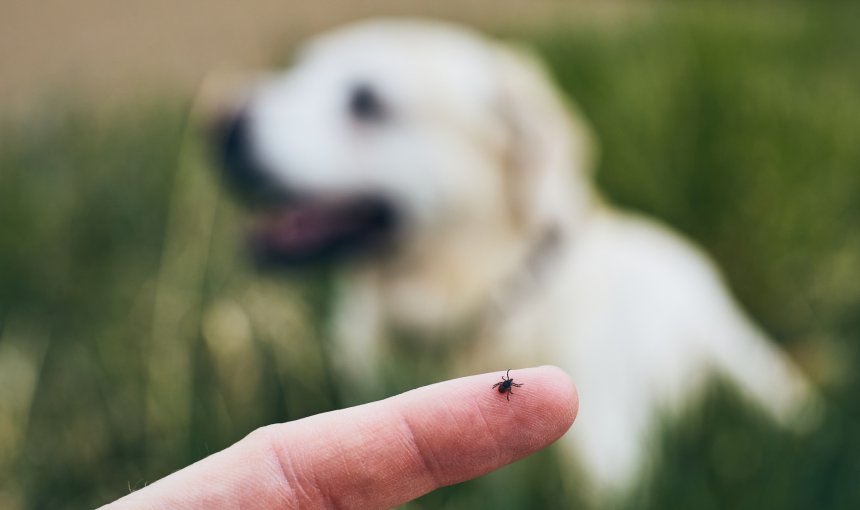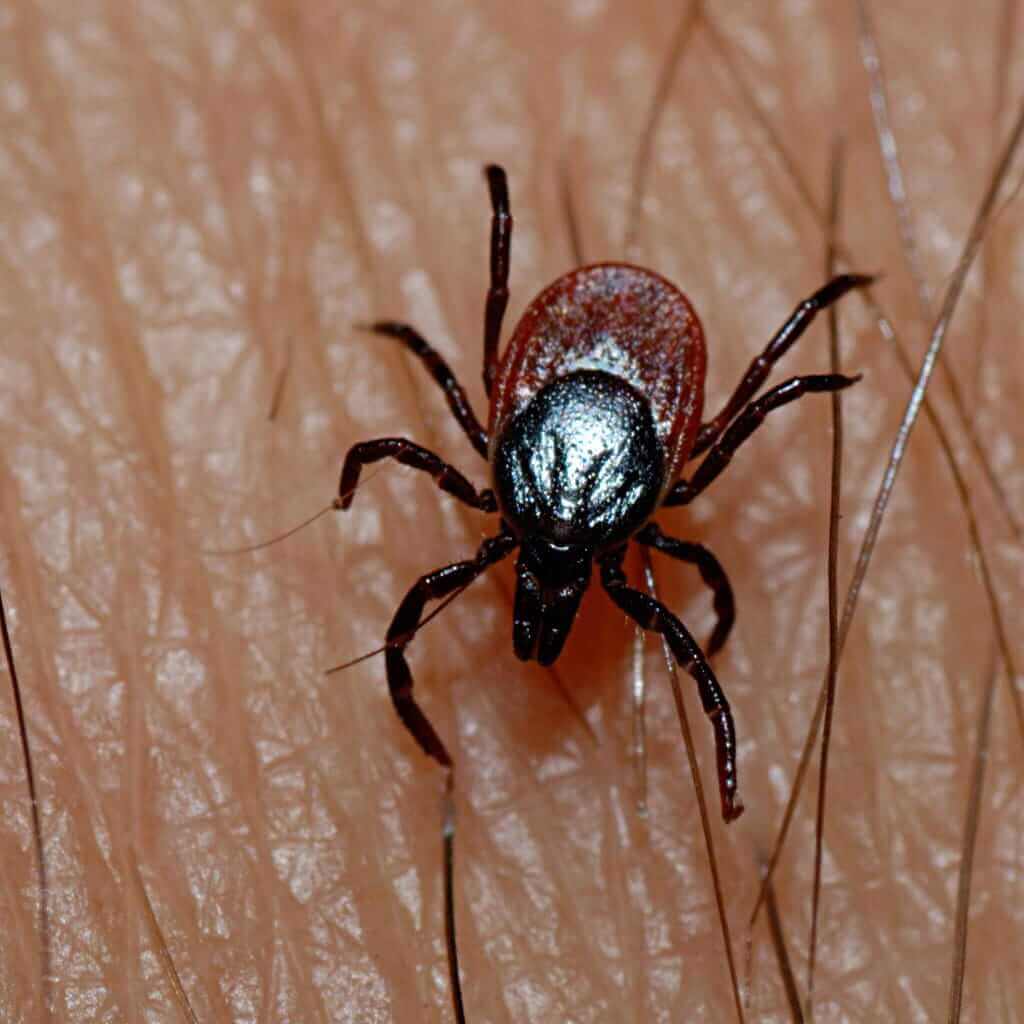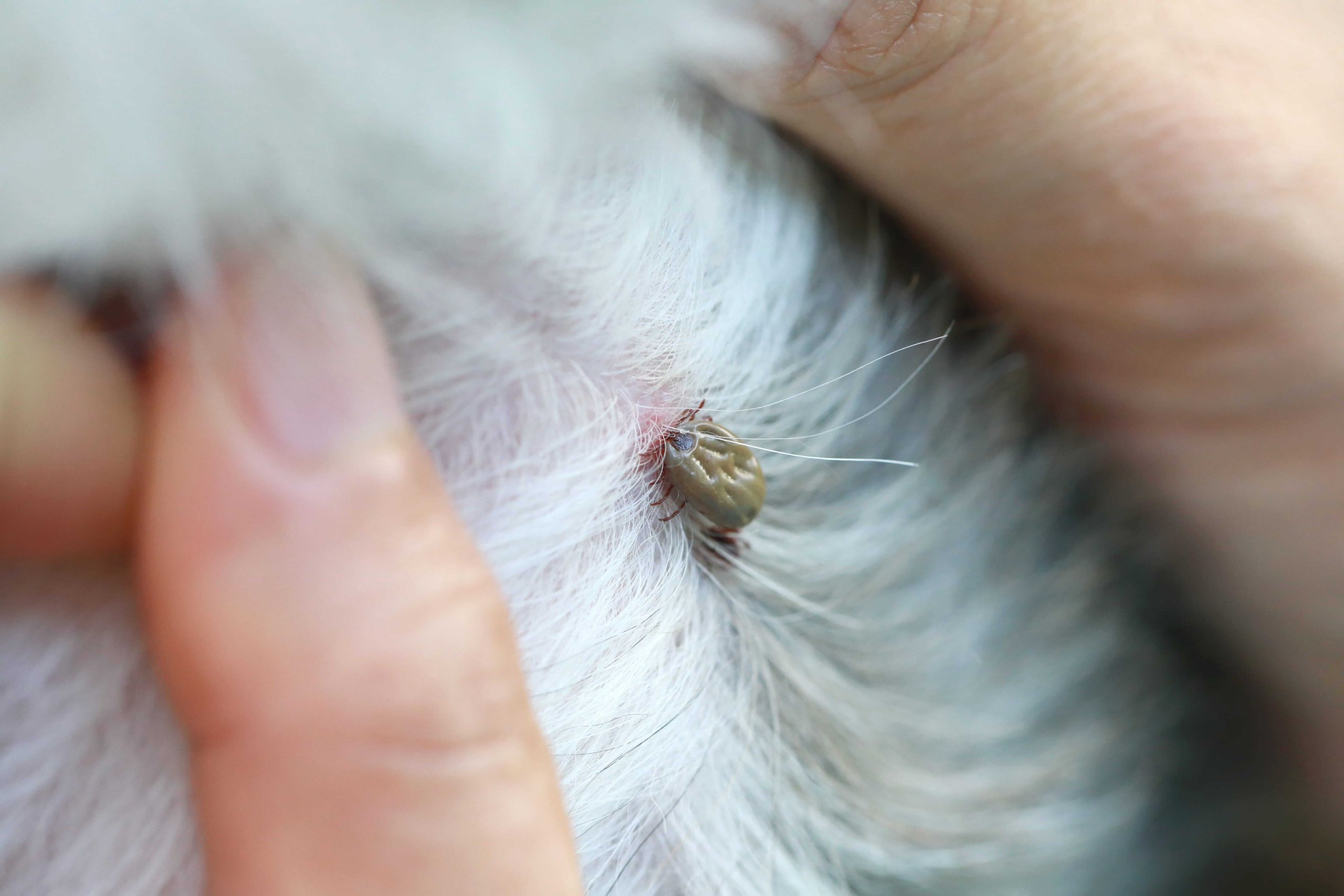 Approved by Dr. Dwight Alleyne, DVM
Approved by Dr. Dwight Alleyne, DVM Flea & Tick Prevention For Dogs: Your How-To Guide
As you and your buddy head outdoors more often, it's likely you'll run into some pesky itchy critters out there. So here's how to get started with a simple flea and tick prevention plan - and stick to it!

Spending more time outside with your favorite furry friend now that it’s warmer? Sweet. Coming home to find them scratching themselves to bits? Not so sweet! So here’s everything you’ve ever wanted to know about tick control and flea prevention for dogs – including how to mark out any “itch”-prone zones in your neighborhood to avoid.
Key Takeaways
Check your dog all over after every outdoor adventure, especially between their toes, under their legs, and around their neck.
Remove a tick as soon as you find it by grabbing it close to your dog’s skin with tweezers or a special tool and pulling it straight out. The faster you remove it, the less chance your dog has of getting sick from a disease like Lyme disease.
The best way to keep your dog safe is to use a preventative method like a tick spray, medicated shampoo, or a special collar. Always talk to your vet first to figure out the best product for your dog.
The Tractive smart dog tracker can help you figure out where the “tick hotspots” are in your neighborhood. You can check your dog’s map on your phone to see where they spend the most time so you can either check them extra carefully after visiting that spot or avoid it altogether.

Always know your buddy is healthy & safe
Read more- Key Takeaways
- What are ticks , fleas & mites? Is there even a difference?
- Where do these parasites like to hang out?
- How to check your dog for tick bites
- How to remove a tick from a dog
- When to see a vet after a tick bite on dog
- Flea & tick prevention for dogs : Simple steps you can take
- Where a smart dog tracker can help
What are ticks, fleas & mites? Is there even a difference?
There is! All three of these critters count as parasites – meaning they need to feed off another animal to survive.
Ticks are small insects part of the spider family. They’re usually colored reddish brown, dark brown, or black. While only around a few millimeters along, a well-fed tick can swell to the size of a coffee bean once it’s done feeding!
Mites are also related to spiders and are just a bit smaller than ticks. (These two are actually cousins.)
Fleas are another species of flightless insects that are also reddish-brown or generally dark in color.

Importantly, all three of these little creatures usually come out in summer. When not latching on to and feeding from animals, some – like fleas – might even move on to humans.
From this latching and feeding, ticks can transmit diseases, like Rocky Mountain spotted fever, Lyme disease, and more.
Where do these parasites like to hang out?
Ticks, mites, and fleas all tend to hang out around grassy wooded areas outdoors, or even near bird’s nests. (Though some species of fleas and mites like the indoors too – including your furniture, floorboards, beds, and pillows!) So your dog is likely to run into them while on your walks, runs, or even hikes outdoors. They can end up biting and latching on to your dog’s skin without you spotting them. And left untreated, this can lead to a pretty nasty case of itching and pain.
These critters can’t jump or fly. Instead, they cling to you (or your dog) as you two pass by. Once they’ve found a host, they bury their teeth inside the skin and the feed for days. It typically takes 24 – 48 hours for a tick to transmit a disease to its host1
💡That’s why it’s a good idea to figure out what spots your dog likes to hang out in best – so you can figure out any tick-, mite-, or flea-prone areas in your neighborhood and avoid them as best as you can. A smart dog tracker can help you figure out how to do this with just a glance at your phone.

Follow your dog anywhere
Get real-time location information, wherever they go. And find out when they try to make an escape, or just when they go somewhere they shouldn’t, with Virtual Fences.
How to check your dog for tick bites
So how do you check for a tick bite on dogs? After a day out in high tick risk areas, be sure to carefully check your dog for ticks. They look and feel like a small bump on your dog’s skin. Search with both your eyes and your hands. Check between your dog’s toes, inside the ears, between the legs, and around the neck. (All itch-prone areas!) If you notice a small, unusual bump, pull the fur back to look closer.
But what exactly does a tick look like on a dog? Or more specifically, a tick bite on dogs? We’ve put an image below for reference. A warning; it might be a bit triggering.

How to remove a tick from a dog
As soon as you find a tick, use tweezers to remove it as close to the body of your dog as possible. Then, continue checking for additional tick bites on your dog. Be as thorough as you can be and try to remove them all. Remove the tick as soon as possible and make sure to remove the tick’s entire body. You can find tick removal tools pretty easily at your local supermarket or drugstore.
The longer the tick stays attached to the dog, and the more of it is attached, the higher the chances of your dog getting infected by something the tick is carrying, such as Lyme disease.
When to see a vet after a tick bite on dog
If your dog has had a tick bite, it’s a good idea to monitor them carefully afterwards to make sure they’re not showing any signs of illness. If they appear sick or unwell, take them to the vet as soon as possible. For example, your dog might have got Lyme disease, which can have the following symptoms:
- Fever
- Reduced appetite
- Decreased energy
- Difficulty walking
- Pain, discomfort or stiffness
- Swollen joints2
💉 Also, talk with your vet about vaccinating your pet against Lyme disease, and about the best way to prevent fleas and ticks from latching on to your your beloved pet.
Flea & tick prevention for dogs: Simple steps you can take
Tick sprays
Tick spray kills ticks quickly and provides some short-term protection. You can use a spray if you’re planning on spending time out in wooded areas with your dog. Just be careful when using it around your dog’s face, and don’t use it on or around any other animals in the home. Tick sprays often contain Permethrin (meant for dogs only) or Pyrethrin. Watch out if you’ve got cats at home, since permethrin can be toxic to them!
You don’t have to soak your dog with the stuff, but be sure to spray all over so everything’s covered. Make sure to follow your vet’s advice and the manufacturer’s directions on how often to spray.
Tick shampoos
Bathing your dog with a shampoo that contains medicated ingredients will generally kill ticks on contact. This can be a low-cost way of protecting your dog during peak tick season. Just make sure to use a product that’s recommended to you by your vet.
To properly use a flea & tick shampoo, be sure to work the shampoo in over your dog’s entire body. Then, leave it on for at least 10 minutes before you rinse it off. Again, remember to protect your dog’s face – especially the eyes and ears. You will need to repeat the process about every two weeks, as its effects tend to wear off.
Other anti-tick products you could consider
Anti-tick powders are generally easy to apply, but can create a mess. If your dog has asthma, powders may not be the best choice, since your dog might inhale some of it.
With your vet’s approval, some oral flea and tick products can help kill parasites within 2 hours of them eating a meal.
Finally, other products include special flea dips and some combination products, which target multiple pests.
Tick collars
Collars that repel ticks are easy to use, though they are mainly useful for protecting the neck and head from ticks. The tick collar needs to make contact with your dog’s skin in order to transfer the chemicals onto the dog’s fur and skin. Which is why we’d always recommend you ask your vet before putting a tick collar on your dog.
If you go for this option, make sure there’s just enough room to fit two fingers under your dog’s collar. Cut off any excess length of collar to prevent your dog from chewing on it. Check the package for information to see how long it offers protection. Finally, watch carefully for any irritation under the collar. In case you see signs of irritation, you may need to use a different product.
Keep in mind that many tick collars become less effective when they get wet. (Not a good idea if you’ve got a dog that loves splashing around in lakes and ponds!)
Where a smart dog tracker can help
When you’re fighting fleas and ticks, prevention is your best bet. A smart dog tracker can give you an extra edge by helping you locate the actual problem areas and monitor your dog’s health more closely.
Strapped to your dog’s collar, your trusty Tractive device can help you:
Figure out where your dog might be running into pests
Fleas and ticks love certain environments – like tall grass, wooded trails, or even an unkept corner of your neighbor’s yard. A Tractive smart dog tracker helps you identify these high-risk zones. If you take your dog hiking or to a new park, you can use the LIVE tracking to see exactly where they’re exploring. If they wander into a dense, overgrown patch of grass, you can call them back immediately, reducing their chance of picking up a tick.

From your app, you can look at a map of your dog’s movements over time. The Heatmap will clearly show where your dog spends the most time outdoors. If your dog is consistently picking up pests, chances are those pests live right where the Heatmap is darkest. This helps you figure out if you need to treat a specific part of your yard or if you need to steer clear of a specific trail on your walks.
Spot potential health issues early
Even with the best preventatives, a sneaky pest can sometimes cause a reaction. The Tractive tracker’s health features act as an early warning system. With its built-in motion detector, it monitors your dog’s movement and rest. If your dog is suddenly scratching non-stop from a flea bite, their sleep might be restless and broken, or their activity levels might drop if they feel unwell.
With time, the tracker learns your dog’s normal patterns. If it notices a big, sudden change in their activity or sleep, you’ll get an instant Health Alert. This can prompt you to do a thorough check of your dog’s coat right away, letting you spot a hidden tick or the tell-tale signs of flea dirt much earlier than you might have otherwise. Catching on to it early means faster treatment and less discomfort for your dog.
Your furry friend’s health and wellbeing means as much as to us as it does to you. So we’ve made it a priority to only share medically-relevant content on our blog. This post was checked, double-checked, and medically verified by Georgia-based vet, Dr. Dwight Alleyne.

Dr. Dwight Alleyne, DVM
Originally from Long Island, New York, Dr. Alleyne began his career at a no-kill animal shelter before becoming a licensed veterinary technician. He graduated from Cornell University Veterinary College in 2006 and completed an internship at Purdue University. Now practicing in Georgia, Dr. Alleyne specializes in soft tissue surgery and ultrasounds. He also writes pet health articles on his website, “The Animal Doctor Blog” (www.anmldrblog.com).



